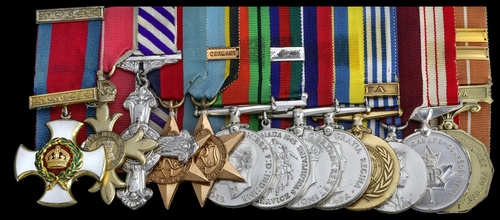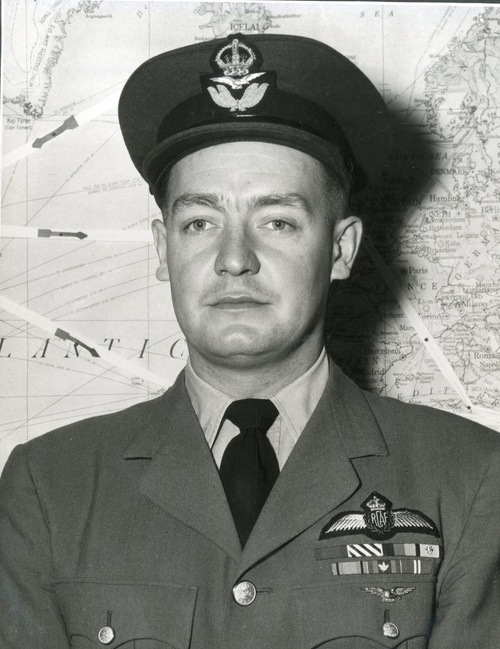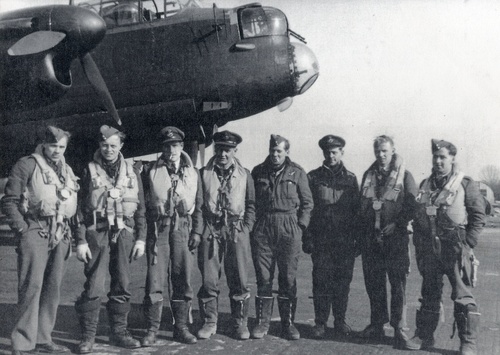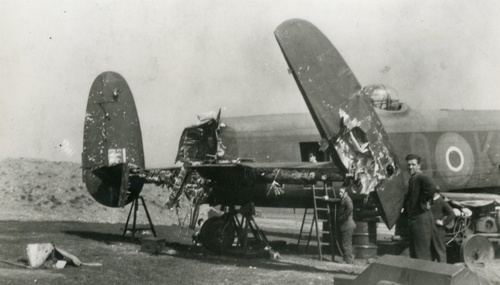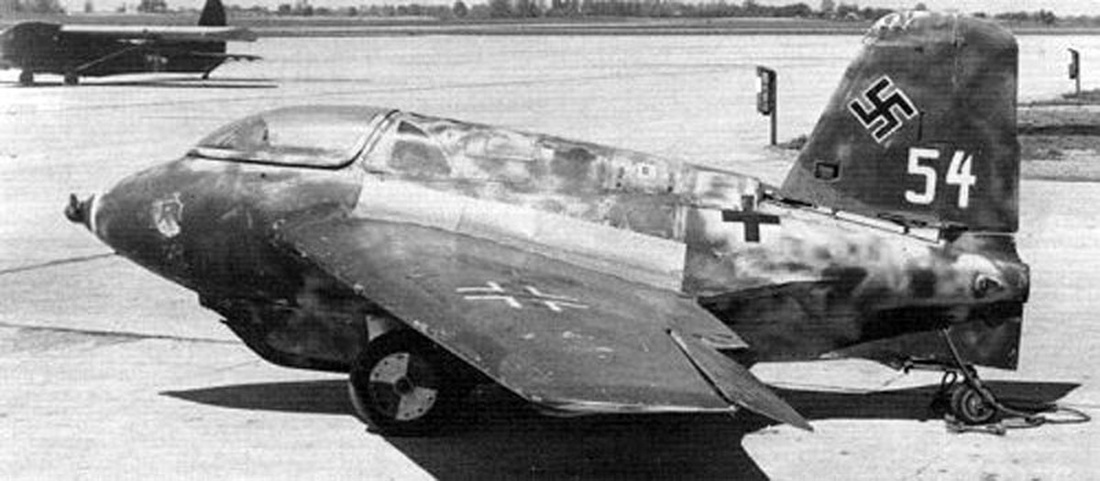Auction: 18001 - Orders, Decorations and Medals
Lot: 49
'The great feat of airmanship performed by Squadron Leader Mussells is amply endorsed by a comment made by Sir Roy Dobson of A. V. Roe & Company Limited. When he saw photographs of the Lancaster and reported on the damage, he remarked, 'How the machine got home at all is entirely beyond us here … '
The recommendation for an immediate D.S.O. to Squadron Leader C. H. Mussells, No. 405 (R.C.A.F) Squadron, refers.
The outstanding Path Finder Force pilot's D.S.O., D.F.C. and Korean War O.B.E. group of thirteen awarded to Brigadier-General C. H. Mussells, Royal Canadian Air Force
Having already won a D.F.C. for his gallant work in No. 405 (R.C.A.F.) Squadron - the only Canadian unit to serve in the Path Finder Force - he added an immediate D.S.O. to his accolades following a spectacular encounter with a rocket-powered Me. 163 over Leipzig on the night of 10-11 April 1945: the enemy fighter blew away his Lancaster's rear turret and starboard rudder
The stricken bomber rapidly fell 4,000 feet, Mussells having to exert all his strength to lash back the flying column with a length of rope to keep the nose of the aircraft up. He then undertook one of the most epic flights in the annals of Bomber Command history - minus his rear gunner and with his mid-upper gunner severely wounded
On reaching the U.K. - and rapidly losing altitude - he ordered his crew to bale out. He subsequently carried out a 'masterly landing' without flaps - although 'the tail would not go down and the aircraft did four very big bounces before finally coming to a rest'
Distinguished Service Order, G.VI.R., silver-gilt and enamel, the reverse of the suspension bar officially dated '1945'; The Most Excellent Order of the British Empire (O.B.E.), Military Division, Officer's 2nd type breast badge, silver-gilt; Distinguished Flying Cross, G.VI.R., the reverse officially dated '1945'; 1939-45 Star; Air Crew Europe Star, clasp, France and Germany; Defence Medal 1939-45, silver; Canadian Voluntary Service Medal 1939-45, with overseas clasp; War Medal 1939-45, silver; Korea 1950-53, silver (19523 Mussells C.H.), officially inscribed; U.N. Korea 1950-54 (19523 Mussells, C.H.), officially inscribed; Coronation 1953; Canadian Confederation Medal 1967; Canadian Forces Decoration, G.VI.R., 2nd issue, the reverse of the suspension bar officially inscribed, 'W./C. C. H. Mussells', mounted court-style as worn, the reverse centre of the D.S.O. removed for mounting purposes, otherwise generally very fine or better (13)
To be sold with the recipient's Path Finder Force (P.F.F.) badge and Canadian 'Operational Wings', together with a silver medal of the Mission for Assistance to the Allied Armies, the reverse inscribed 'Group Captain C. H. Mussells, R.C.A.F., Paris, le 8 Mai 1967'
D.S.O. London Gazette 17 July 1945. The original recommendation states;
'On 10 April 1945, this officer was pilot of an aircraft detailed to make a daylight attack against Leipzig. Whilst orbiting the target to complete a second run the aircraft was attacked by an enemy fighter. The rear turret and the starboard rudder were completely shot away, the port rudder shattered and both elevators damaged to such an extent that they offered no control surface. The Mid-upper Gunner was severely wounded in the combat.
The aircraft lost speed suddenly and, almost completely out of control, dived some 4,000 feet. Squadron Leader Mussells attempting to pull out of the dive found the trimming controls completely useless, but with considerable difficulty - and with his full strength - eventually pulled out and the control column then had to be lashed by rope to keep the nose of the aircraft up. The aircraft could only turn to port but by using the ailerons could be eased to starboard, the constant tendency to turn to port still persisted.
By his sound judgment and skilful airmanship, Squadron Mussells regained partial control of his aircraft, and set course for base. For the first hour of the return journey he flew at 13,000 feet, crossed the Belgian coast at 10,000 feet and eventually crossed the English coast at 5,000 feet, when he instructed his crew, with the exception of the wounded Mid-upper Gunner, to bale out. He then carried out a masterly landing at Woodbridge without flaps, and with the control column still lashed back. On landing the tail would not go down and the aircraft did four very big bounces before finally coming to a rest.
The great feat of airmanship performed by Squadron Leader Mussells is amply endorsed by a comment made by Sir Roy Dobson of A.V. Roe & Company Limited. When he saw photographs of the Lancaster and reported on the damage, he remarked, 'How the machine got home at all is entirely beyond us here.'
Squadron Leader Mussells showed complete disregard for his personal safety and a high sense of duty in bringing the aircraft back to this country, so that his crew, except the wounded gunner, could bale out in home territory, and further in attempting a most hazardous landing which was the only practical means, if successful, of enabling his wounded crew member to receive adequate medical assistance.
This officer's perseverance in the face of great odds, together with his exceptional skill and resources, has set an inspiring example, and I strongly recommend him for the immediate award of the Distinguished Service Order.'
O.B.E. London Gazette 5 June 1952. The original recommendation states:
'Wing Commander Mussells has commanded No. 426 (Transport) Squadron, R.C.A.F., on duty with the United nations forces on the Korean airlift since the commencement of the operation on 19 July 1950. Throughout these operations Wing Commander Mussells' exceptional leadership has been reflected in the excellent achievements of the unit. His organisational ability, devotion to duty, enthusiasm and example, has given him a well co-ordinated and effective unit which has surpassed in all respects the commitments assigned to it.
For his outstanding efforts in support of the United Nations' policies, it is most strongly recommended that Wing Commander Mussells be an Additional Member of the Most Excellent Order of the British Empire (O.B.E.).'
D.F.C. London Gazette 17 June 1945. The original recommendation states:
'Squadron Leader Mussells has completed attacks on heavily defended enemy targets such as Kiel, Dortmund and many others. At all times he has displayed a fine fighting spirit and has proved himself an officer of outstanding ability, whose cool determination, cheerfulness and devotion to duty have been an inspiration to his squadron.'
Campbell Haliburton Mussells was born in Montreal on 20 June 1920 and was educated at Westmount High School and McGill University.
Enlisting in the Royal Canadian Air Force in December 1939, he was commissioned Pilot Officer in January 1940 on being selected for pilot training. Three years later, and having served as an instructor at Trenton, he was embarked for the U.K. where he attended the Empire Central Flying School.
He appears to have commenced his operational career in No. 426 (R.C.A.F.) Squadron in September 1944, in which capacity he participated in sorties to Frankfurt and Kiel. But he subsequently transferred to No. 405 (R.C.A.F.) Squadron, a Path Finder Force (P.F.F.) unit operating in Lancasters out of Gransden Lodge in Bedfordshire.
Path Finder Force
A busy tour of operations ensued, Mussells and his crew being detailed to a succession of heavily-defenced targets in Germany in the period leading up to April 1945.
Their targets included Cologne and Hamburg - both cities on three separate occasions - in addition to Dusseldorf, Essen, Frankfurt; so, too, the Urft Dam in early December 1944 and, in February 1945, the first of the 'firestorm' raids on Dresden.
Recommended for his D.F.C. after 30 operational sorties in the period September 1944 to March 1945, Mussells then carried out further sorties to Hamburg and Kiel before being detailed to a daylight strike against Leipzig on 11 April 1944. This was his 35th - and last - operational trip of the war; undoubtedly his most memorable, too.
Taking-off from Gransden Lodge, Bedfordshire in Lancaster III 'K' ME 315 at 2.43 p.m., he reached and attacked his target before being jumped by a rocket-powered Me. 163. As described above, his aircraft was all but mortally damaged and his epic flight back to England ranks among one of finest on record.
His wounded Mid-upper Gunner - Pilot Officer R. T. Dale - survived his ordeal but the Rear Gunner - Flight Lieutenant M. L. Mellstrom died in his turret. His remains were recovered by British P.O.Ws and buried at the cemetery of the Luthren Evangelical Church at Engelsdorf on 13 April 1945. They were later exhumed and moved to the Berlin War Cemetery.
In the period immediately after the war, Mussells successfully completed the R.C.A.F. Staff College course and served as C.O. of the R.C.A.F. Sation at Winnipeg. He was invested with his D.S.O. and D.F.C. in a ceremony held at Montreal on 25 November 1949.
Korea - O.B.E. - and beyond
He subsequently played a key role in the Korean War airlift as Wing Commander in command of No. 426 (Transport) Squadron.
The Squadron's Canadair North Star aircraft flew 600 Operation "Hawk" trips, carrying 13,000 men and 7,000,000lbs. of freight and mail across the North Pacific between Vancouver and Tokyo. As described in an article in the Legion Magazine, Mussells' skills as a pilot were once more called upon:
'Operation "Hawk" was accomplished with no fatalities but there were some close calls and more than a few incidents. On 15 September 1950, Wing Commander C. H. Mussells, C.O. of No. 426 Squadron, departed Chord from Elmendorf with American soldiers and anti-tank ammunition. Both were urgently needed in Korea, so the aircraft had been permitted an overload clearance.
Three hours after take-off, one of the Merlin engines began overheating through the coolant system. Mussells shut down the engine, feathered the propeller and prepared to return to McChord. Then a second engine on the same wing overheated. It was also shut down. There was now no question about getting to McChord and Mussells prepared for an emergency landing at Sandspit on Moresby Island.
To lighten the aircraft, Mussells dumped excess fuel. Some passengers mistook the misty gasoline trail for smoke, panicked and crowded to the back of the fuselage, as if would have offered safety. This complicated the process of trimming the aircraft for landing. A crewman ordered everyone back to their seats but the soldiers could not have been reassured as the North Star flew over a crashed U.S.A.F. aircraft, its tail sticking out of the water during the final approach to Sandspit. Happily, Mussells landed safely.
On 19 April 1951, a North Star piloted by Flight Lieutenant J. A. Watt was on a route-training flight to an unfamiliar field - Ashiya - located between Osaka and Kobe, Japan. He was cleared by Ashiya tower to descend from 4,000 to 3,000 feet. At 3,400 feet the aircraft hit trees atop a hill that was not even indicated on the airfield map. No one was injured but the aircraft sustained considerable damage to its nose, oil cooler and exterior radio aerials. The pitot head was also wiped out and with the airspeed indicator. The aircraft also lost the use of an engine.
Fortunately, the passenger included three of the most experienced North Star captains in the R.C.A.F.: Wing Commanders C. H. Mussells and J. K. MacDonald, and Flying Officer Robert Edwards. After assessing the damage, Mussells ordered MacDonald and Edwards to complete the landing, which they did.'
Mussells was awarded the O.B.E., the only such award to R.C.A.F. personnel for "Hawk"; he added the Coronation Medal to his accolades in 1953 whilst serving as Group Captain, Air Transport Command.
His subsequent commands and appointments included a spell on the Canadian Joint Staff in London in the 1960s, as Director-General of Personnel Services of Canadian Forces Abroad and then as Commandant of National Defence College at Kingston. He retired as a Brigadier-General in 1974; sold with a file of copied research.
Subject to 20% VAT on Buyer’s Premium. For more information please view Terms and Conditions for Buyers.
Sold for
£6,000

